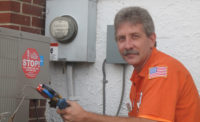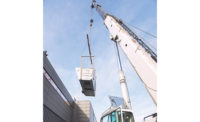Over the past few years, the U.S. Department of Energy (DOE) has issued dozens of regulations affecting HVACR equipment manufacturers, including new regional energy conservation standards for split-system central a/c units and heat pumps as well as standards for commercial refrigeration products. Additionally, refrigerant regulations and technological innovations in variable-speed technology have resulted in a bevy of changes for condenser unit manufacturers.
MEETING REGULATORY EXPECTATIONS
Matt Barga, residential HVAC portfolio leader, Trane and American Standard, said a/c manufacturers have had to adapt to regulatory changes affecting both efficiency requirements and refrigerants.
“Beginning in 2015, air conditioners [condensers] experienced a change in the minimum-efficiency standards with the implementation of the regional standards that moved Southern markets from 13 to 14 SEER and added a full-load EER requirement in the Southwest, in addition to 14-SEER requirements,” he said. “Trane and American Standard, both owned by Ingersoll Rand, designed new 14-SEER systems for Southern markets with a subset of models designed to meet the Southwest EER requirements. At the other end of the efficiency spectrum, both brands have … [introduced] variable-speed condensers. This technology provides very high efficiency in both 18- and 20-SEER price points that provide a significant improvement in comfort in terms of sound, humidity levels, and temperature distribution.”
Lynn Turner, product manager, Carrier Corp., also said regional standards have affected the company’s product lineup. “Regional standards requirements have created segregated minimum-efficiency levels for the Southwest [14 SEER, 12.2 EER/11.7 EER], Southeast [14 SEER], and North [13 SEER],” she said. “Regional standards are driving the regional minimum-efficiency change and inverter technology is driving more high-efficiency variable-speed products. We are investing heavily in our ability to deliver cost-effective inverter technology to a far greater group of homeowners that will provide both increased comfort and lower operating costs.”
Farooq Mohammad, director, product management, air conditioning division, Rheem Mfg. Co., said efficiencies have, over time, gone higher and higher, and the challenge has been addressed via heat exchanger surface area and airflow, for the most part. “Variable-speed technology has provided the leap forward for condensing units. This technology allows the unit to operate at a wide range of speeds in order to precisely adapt cooling and heating capacities to current demands. In fact, the new Rheem Prestige™ Series EcoNet™-Enabled Variable Speed Heat Pumps and Air Conditioning Units offer efficient cooling and heating performance. The HVAC industry will rely upon inverter technology increasingly in the future to deliver affordable, optimal comfort solutions.”
Regulatory actions have raised the baseline efficiencies and, in parallel, manufacturers have pushed the efficiency boundaries to maintain a good-better-best offering, Mohammad added. “For Rheem, contractor feedback, consumer needs, and government regulations all drive our product development efforts, which have led to creating more higher-efficiency, inverter-driven products.”
Regulations and standards are also affecting commercial condensing units, said Skip Ernst, manager, trade association and regulatory bodies, Daikin Applied.
“Commercial condenser full-load efficiency, per ASHRAE’s Standard 90.1 [20 tons and over], has not changed much over the past few years,” he said. “However, we are seeing an increase in market demand for variable-capacity technology on condensing units in order to better match application loads. This can be accomplished through staged compression or digital scroll compressors that provide improved part-load capabilities. When combined with variable-speed drives for fans and advanced controls, better temperature and humidity control is achieved and system energy consumption is lowered.”
Requirements for increased ventilation air, more emphasis on building energy efficiency, and improved comfort control are also driving innovation in the commercial market, Ernst added. “Standards and technologies have remained stable for commercial condensing units, but as part of an overall system, air handlers have become much more efficient. This is largely due to how building efficiency is being transformed by HVAC standards [like ASHRAE 90.1] and newer technologies that include variable-speed drives, high-efficiency fans, and fan arrays.”
Ben Picker, Copeland product manager, Emerson Climate Technologies Inc., also pointed to new regulations from the DOE as having an influence on commercial refrigeration equipment, including condensing units, in recent years.
“The latest increases that take effect over the next couple of years require improvements of up to 50 percent for some equipment,” he said. “Unit efficiency has moved from being an afterthought to now being one of the primary factors in unit selection. Store operators are looking at total store energy usage, which is driving a shift in refrigeration system architecture.
“It used to be said, ‘Just give me cold,’” he continued. “That usually turned into small, self-contained systems that would supply the cold for that particular need. Even with the most efficient systems, the heat load created by those systems would then have to be removed from the building by an air conditioning system. This created a very inefficient total system, even if the individual condensing units were efficient by themselves. Emerson has developed products that address the entire system.”
REFRIGERANT REGULATIONS
Additionally, the R-22 phaseout, which will end all production and importation of virgin R-22 in the U.S. by 2020, has affected condensing unit products significantly over the past few years.
“It has eliminated the dry R-22 offering, which was frequently used for low-cost replacement solutions,” Barga said. “Volume of dry R-22 declined steadily with more and more customers switching to R-410a condensers due to refrigerant cost, warranty, and the overall economics of the replacement solution.”
Picker also pointed out how R-22 unit production has been decreasing for years. “As we move into the next generation of units designed to operate with new refrigerants, like R-448/449, R-450, and R-513, many of the new compressors will no longer be approved to operate with R-22,” he said. “While some units with scroll compressors will continue to support operation with R-22, the vast majority of our units will no longer support operation with R-22.”
“For more than a decade, the industry has migrated to higher-efficiency, newer units designed, engineered, and manufactured to use R-410a, which is an ozone-safe refrigerant,” Mohammad said. “There are no limitations on the use of R-410a, and newer units provide much higher efficiency ratings overall. Thus, Rheem continues to work with its distribution, wholesale, and contracting partners to support replacement of R-22 units with much more efficient R-410a systems.”
DESIGN IMPROVEMENTS
To meet increasingly stringent energy-efficiency requirements, condensing unit manufacturers are looking at several ways to improve overall equipment design.
As part of the transition to R-410a, microchannel coils have enabled more heat transfer per square foot and created more robust design capabilities, Ernst said. “Microchannel coils also require less refrigerant, which helps achieve LEED [Leadership in Energy and Environmental Design] point certification and decreases overall unit weight. Additionally, improved condenser fan blade design with energy-efficient motors and variable-speed drives creates a better overall system that can be optimized to work more efficiently and create less noise.”
Compressor technology has played a large part in improving overall unit efficiency, Picker said. “Scroll compressors are the single most important advancement in unit efficiency and reliability. With few moving parts, scroll compressors are inherently reliable. They are also inherently more efficient due to the volumetric efficiencies offered by scroll compression compared to reciprocating piston compression. Advances in fan blade design and variable-speed motors allow units to operate almost silently. New protective coatings allow condensers and cabinets to cost-effectively weather extreme environmental conditions that would quickly corrode with previously available costly coatings.”
Barga also mentioned how compressors have played a significant role in improving overall unit efficiency. “The ClimaTuff™ and Duration™ compressors we use in our systems are of the latest generation in a heritage of quality and reliability, designed and optimized to deliver efficiency capable of meeting the new regional efficiency standards,” he said. “We continue to use all-aluminum SpineFin™ condenser coils, which is the industry standard in efficiency and corrosion resistance. We have also focused on fan blade designs that minimize and improve the customer’s noise experience.”
Examples of updated components on Rheem’s Prestige product line include improved tubing design, which reduces opportunity for leaks, Mohammad said. Additionally, the company has introduced “a new composite base pan, which adds durability and eliminates corrosion while providing quieter operation with 35 percent fewer fasteners than previous designs and aluminum evaporator coils, which provide a more reliable, durable design than previous models with conventional coils.”
IMPROVED SERVICEABILITY
In addition to improved efficiency, manufacturers have also concentrated on improving installation and serviceability of condensing units.
“The expectations of the dealer and the consumer for serviceability and ease of installation have increased in recent years,” said Ken Ely, product manager, heat pumps and air handlers, unitary products group, building efficiency, Johnson Controls Inc. “Dealers are independent business people, so, to them, time is money. York’s LX Series residential split systems respond to this expectation with a contractor-friendly design that improves serviceability.”
“At Trane and American Standard, we always focus on ease of installation, configuration, and serviceability of our products,” Barga said. “We design our condensers with the dealer in mind, improving the quality and reliability experience of both the dealer and the homeowner. Our variable-speed systems, paired with Nexia™ Dealer Diagnostics, have taken this to the next level by allowing dealers the ability to remotely monitor customers’ systems to diagnose problems before they cause issues for the homeowner.”
A shortage of qualified refrigeration technicians means those who are servicing refrigeration equipment are pressed for time and need to move on to the next job as quickly as possible, Picker said. “Equipment that is being designed today must factor in ease of use and serviceability. Lightweight units and units with service ports, filter driers, sight glasses, and other pre-installed components streamline and speed up service calls. Also, units with onboard diagnostics allow technicians to more quickly and accurately diagnose issues. This allows a technician to correct a problem the first time rather than lose time and money on a return visit.”
Mohammad said Rheem strives to listen to its contractor customers to determine how to improve unit installability and serviceability. “Our customers have responded very well to this commitment because we’ve been able to really listen and take their wish list of features and make them a reality,” he said.
CONNECTIVITY AND CONTROL
In addition to innovations in compressor and inverter technologies, condensing units are becoming smarter and more connected than ever.
“At installation, these systems auto-detect and self-configure many settings for the unit, which simplifies the installation,” Barga said. “We’ve also designed a dealer-centric configuration using an on-board communicating display accessory [CDA] to make it easy for our dealers to have confidence that the unit is configured properly. Once the Nexia thermostat controlling the system is connected to the internet, dealers can remotely monitor the performance and health of the variable-speed system using Nexia Dealer Diagnostics. This allows dealers to remotely read sensors and error codes, which enables the dealer to identify problems before they impact the consumer experience, or enable the dealer to have the right technician with the right skill set and parts to be able to fix the unit in one visit. This is truly a game-changing advantage for our customers.”
Consumer demand drove Rheem to develop home automation products that are smarter, more efficient, and can be controlled at home or away. “We jumped on board to offer EcoNet and spent four years perfecting the product,” Mohammad said. “The Prestige Series Variable Speed Heat Pumps and Air Conditioning Units are the latest addition to our smart offerings.”
York recently began offering its Wi-Fi- and smartphone-compatible Affinity™ Residential Communicating Control and new touchscreen residential thermostat with proprietary hexagon interface, which “demonstrates the influence that connectivity and the Internet of Things have upon our products,” Ely said. “Both seamlessly connect homeowners to their HVAC systems via their smartphones, tablets, or computers. Additionally, convenient reminders and alerts can be sent directly from the system to consumers.”
Remote diagnostics have also become more popular on both residential and commercial condenser units, Ely added. “Should an issue arise with the system, the consumer will receive service notifications and be presented with the appropriate dealer contact information.”
Consumer expectations, not government regulations, are the primary driver of recent innovations in connectivity, Ernst said. “End users are looking to use smart building technology to enable precise environment control with an increased focus on comfort and business outcomes,” he said. “Daikin Applied currently offers our Intelligent Equipment® option on Rebel®, Maverick® II, and RoofPak® rooftop equipment and continues to explore how customers may benefit from extending to other platforms. Currently, condensing products can easily integrate into building automation systems, which enables more connected operations.”
Improved controls and connectivity have drastically improved troubleshooting and service, Turner added. “These tools are invaluable for technicians in the field due to their ability to rapidly diagnose a system’s failure and, subsequently, service more customers in a day. We are developing these tools to give the homeowner greater visibility into their system’s operation and contractors greater flexibility.
“Our Wi-Fi thermostats and user-interface controls provide customers greater flexibility and convenience and help them save money,” Turner continued. “The Internet of Things has also changed the way we are thinking about how we can connect with homeowners and, in turn, connect our dealers with their customers. It is helping to open new opportunities with new companies and changing the way we view our solutions and the way we go to market.”
On the commercial side, store operators want to know their systems are operating correctly, and they also want to immediately be alerted when a problem occurs, Picker said. “If the temperature in a refrigerated case is found to be beyond the safe zone, the product is often discarded because it is unknown how long the temperature has been high, and the quality and safety of the product are also unknown. With connectivity and the Internet of Things, our condensing units with on-board diagnostics can automatically alert store operators and service technicians at the first sign of a system issue. This can be hours or even days before a temperature reading is affected.
“With this advanced warning and diagnostics information, systems can be maintained with minimal or even no downtime,” he continued. “Technicians can even monitor and schedule service to avoid emergency night, weekend, or holiday repairs. Some adjustments to the system operation can even be made remotely without ever needing to visit the store.”
WHAT’S NEXT
With so many factors influencing nearly every aspect of condenser unit design, manufacturers anticipate the market will continue to evolve rapidly in the next few years.
“Regulation and consumer demand are currently driving a shift in the industry toward more part-load energy consumption versus full-load energy consumption,” Ernst said. “Also, manufacturers are preparing for the next evolution in available refrigerants. Daikin Applied has already started planning for this shift with new refrigerant-focused work being tested in our Applied Development Center.”
Picker predicts there will continue to be a growing adoption of electronic controls on condensing units. “In order to meet the increasing energy-efficiency requirements and to allow operation with challenging new refrigerants, electronics are needed to control the operation of the unit. These electronics will allow things like low condensing and multi-refrigerant operation and aid in compressor protection. There will also be an increased adoption of modulated compression technologies, including digital and variable speed compressors. With these changes, electronic expansion valves [EEVs] will also become more common.”
“Variable-capacity technology will also continue to become more prevalent, Ely said. “York®’s LX Series 16-SEER heat pump uses inverter-driven variable-capacity technology to dynamically change capacity and airflow to precisely match the comfort requirements of a space. It benefits consumers by giving them more even temperatures, improved humidity control, and, ultimately, lower energy bills.”
Increasing demand for improved efficiency has caused condenser units to grow accordingly, which has resulted in pressure for manufacturers to limit the footprint of condenser units, Mohammad said. Additionally, increasingly stringent regulations will continue to drive changes in condenser unit technology.
“The next 10 years will bring tremendous changes to our industry, mainly driven by government regulations,” he said. “There are new minimum-efficiency requirements to meet, new refrigerants with much lower GWP targets, and new test methods to rate all products. It will be a very busy and challenging time for the industry, but, at the same time, it’s exciting because it will force the industry to be innovative in coming up with better environmentally friendly solutions for consumers.”
Publication date: 6/6/2016
Want more HVAC industry news and information? Join The NEWS on Facebook, Twitter, and LinkedIn today!










Report Abusive Comment